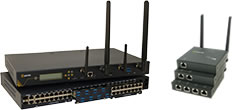
IoT government applications reach new spending heights
By Max BurkhalterFebruary 25, 2022
Governments around the world are increasingly adopting the Internet of Things (IoT) technology and infrastructure. A June 2021 Gartner report indicates a 22% increase in IoT spending over 2021, with global estimates topping $21 billion in 2022. With a focus on endpoint electronics, surveillance equipment and communications systems, here are some of the ways IoT will impact the U.S. government in 2022.
Watchful eye
The Gartner report indicates that over 50% of the over $21 billion spend will be allocated to outdoor surveillance systems. Events like the COVID-19 pandemic, have placed new importance on reinforcing the safety and security of the communities local governments serve.
With $12 billion projected to go to the installation and maintenance of outdoor surveillance technologies, governments are investing on IoT-rich infrastructures that allow near real-time data processing and transmission.
Data from surveillance cameras, drones and body cameras require real-time latency. The importance of recording and transmitting high-quality data can prove essential when acting upon intelligence information gleaned from remote technology captures.
Datagram Transport Layer Security (DTLS) systems prevent unauthorized tampering, or interception, of data as it is transmitted between sources. A January 2021 report from the National Security Agency (NSA) outlined the importance of shifting away from the DTLS predecessor Transport Layer Security (TLS) due to algorithm vulnerabilities deemed obsolete.
Standard Real-Time Transport Protocols (STRP), responsible for securing media itself, was developed in 2004 by the Internet Engineering Task Force (IETF). Combined with DTLS systems, STRP encryption serves for the protection of the data captured by government surveillance systems.

Open RAN could prove costly for US government
As Thomas Duesterberg outlined in an article for Forbes, efforts by the U.S. government to reduce Huwaei's 5G infrastructure has resulted in the emergence of Open RAN (radio access network). Designed to become a technically and economically viable alternative for 5G networks, the Open RAN establishment of 5G-ready technologies hasn't yet lived up to expectations.
As a result, the National Telecommunications and Information Administration (NTIA) has adopted a more aggressive stance on seeing tangible infrastructure results from the proposed technology. An article published on Light Reading captured the show and prove stance the U.S. government has laid out entering 2022.
Given the lack of transparency regarding the cost of RAN equipment, line-of-sight into the spend associated with a future rollout is unclear. The impact of widespread 5G technology could still be felt in the United States this year.
Perle and government technology solutions
Perle has worked with the city of Colorado Springs to implement security cameras and systems that utilize PoE media converters and ethernet switches. As the city looked to establish power to IP cameras and the fiber conversion needed for data transmission, Perle was able to offer equipment that could sustain a Colorado winter. With temperatures ranging from -40°C to +75°C, the local Colorado Springs government trusted Perle for reliable, sustainable solutions, regardless of temperature considerations.
To learn more about Perle's proven track record of enhancing industry technology, check out our government solutions page.



